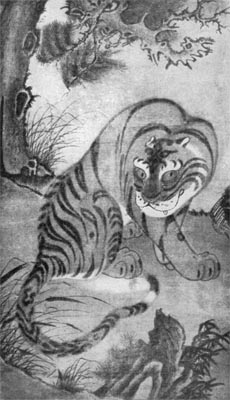CONCLUSION
This brief survey has shown how the distinctive features of China’s artistic activity were distributed. Though subjected to varying influences, this evolution possesses a unity which is quite as complete as is that of our Western art. In the beginning there were studies, of which we know only through written records. But the relationship existing between writing and painting from the dawn of historic time, permits us to carry our studies of primitive periods very far back, even earlier than the times of the sculptured works. We thus witness the gradual development of that philosophical ideal which has dominated the entire history of Chinese painting, forcing it to search for abstract form, and which averted for so long the advent of triviality and decadence.
The goal sought by Chinese thought had already been reached in painting when, in the third and fourth centuries, we are vouchsafed a glimpse of it. It is a vision of a high order, in which the subtle intellectuality corresponds to a society of refinement whose desires have already assumed extreme proportions. Like Byzantium, heir to Hellenistic art, the China of the Han dynasty and of Ku K’ai-chih was already progressing toward bold conventions and soft harmonies, in which could be felt both the pride of an intelligence which imposed its will upon Nature, and the weariness following its sustained effort.

PLATE XXIV. PAINTING BY CHANG CHENG
Eighteenth Century. Collection of M. Worch.
This refinement, arising from the exhaustion of a world which even thus retained a certain primitive ruggedness, was succeeded by a stupendous movement which followed in the wake of the preaching of Buddhism. With the new gods we see the first appearance of definite and long-continued foreign influences. Civilization was transformed and took on new life. Then, as in the days of the great forerunners of the Florentine Renaissance, there appeared a whole group of artists, prepared by the art, at once crude and refined, of an earlier people. This group set resolutely to work at the close study of forms, ascertaining the laws of their structure and the conditions of the environment which produced them. The period in which the work of Li Ssŭ-hsün, Li Chao-tao and Wang Wei was produced may be likened to the fifteenth century in Florence with Pisanelo, Verocchio, Ghirlandajo and Masaccio. Similar conditions gave birth to a movement that is directly comparable with the Italian movement for, no matter how varied the outward appearances due to differences of race and civilization, the fundamentals of art are the same everywhere and pertain to the same mental attitudes.
The great leaders in periods preceding the T’ang dynasty paved the way to the culmination which took place in the Sung period, and thus the fruit of that prolonged activity is seen ripening between the tenth and the thirteenth centuries. Through the gropings of the primitive period, the heterodox philosophies and the mystic stirrings of Buddhism, Eastern thought had arrived at an unquestionably noble comprehension of existence. The impersonal mystery of the universe, its mighty principle, its manifold manifestations and the secret which unveils itself in the innermost soul of things are the conceptions which form the inspiration of Chinese painting. These lofty thoughts are the source of that spirituality which declares itself therein with such nobility. The religion to which they are due will seem perhaps, to certain people, to be broader and less trammeled than our own. There is no doubt that the entire Far East was under the spell of its grandeur.
Up to this point art had sounded every depth and attained the highest summits of human achievement. Thenceforward it concerned itself with varying manifestations which were only the different modes of a formula that was still flexible, until the time when—the great inspirations of the past forgotten—there appear signs of a spirit on the quest for realism, emerging from the ancient tradition. This is the distinctive note in the evolution of Chinese painting under the last two dynasties. It would seem as if, even in this guise, a universal need of the mind is being satisfied, a need which we, too, have known after experiencing a chilling academicism, and when modern culture had overthrown the ancient idols. Chinese painters have thus completed a round analogous to that traveled by our own artists.

PLATE XXV. TIGER IN A PINE FOREST
Eighteenth to Nineteenth Centuries. Collection of V. Goloubew.
For the Far East as for Europe, the problem now presented is that of a revival. Bent beneath the weight of the prestige of the past, too learned in the last word of culture, modern art is seeking to find itself, groping blindly, full of promising but unfinished works. The time has come when there are signs throughout the world of a desire for a universal civilization, by the reconciling of ancient divergences. Europe and the Far East bring into contrast the most vigorous traditions in history. Henceforward there is interest for both civilizations in studying and in coming to understand a foreign ideal. Though incomplete, these pages will perhaps help to show that such a mutual comprehension is not impossible and that, if egotistic prejudices are overcome, apparent dissimilarities will be resolved into a profound identity. Thus will arise the elements of a new culture. In coming to understand a mood which so fully reflects an unknown world, the European mind will discover principles which will make it rise superior to itself. May this broad comprehension of human thought lead Europe to estimate with greater justice a civilization numbering its years by thousands, and to refrain from thwarting the fulfillment of its destiny.





